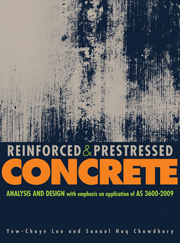Book contents
- Frontmatter
- Contents
- Preface
- Acknowledgements
- Notation
- Acknowledgements for tables and diagrams
- Acronyms and abbreviations
- Part I Reinforced concrete
- Part II Prestressed concrete
- Appendix A Elastic neutral axis
- Appendix B Critical shear perimeter
- Appendix C Development of an integrated package for design of reinforced concrete flat plates on personal computer
- Appendix D Strut-and-tie modelling of concrete structures
- Appendix E Australian Standard precast prestressed concrete bridge girder sections
- References
- Index
Appendix D - Strut-and-tie modelling of concrete structures
- Frontmatter
- Contents
- Preface
- Acknowledgements
- Notation
- Acknowledgements for tables and diagrams
- Acronyms and abbreviations
- Part I Reinforced concrete
- Part II Prestressed concrete
- Appendix A Elastic neutral axis
- Appendix B Critical shear perimeter
- Appendix C Development of an integrated package for design of reinforced concrete flat plates on personal computer
- Appendix D Strut-and-tie modelling of concrete structures
- Appendix E Australian Standard precast prestressed concrete bridge girder sections
- References
- Index
Summary
General remarks
‘Strut-and-tie modelling’ is described in Section 7 of AS 3600-2009 (the Standard). Since the original issue of AS 3600 (1988), the current Standard is the first update in which a separate section is devoted to this type of modelling. This appendix serves to complement Section 7 of the Standard.
Figure D.1(1) shows some typical reinforced and prestressed concrete structures and elements. In terms of stress-distribution characteristics in response to external loads, each structure or element can be divided into the so-called ‘B’ and ‘D’ regions (Schlaich, Schafer & Jennewein 1987). In general, B regions are dominated by bending and D regions (the ‘distributed’ or discontinuous regions) are dominated by nonflexural stresses.
The analysis and design of various B regions have been extensively explored in most chapters of this book. That the strength behaviour of B (bending) regions can be accurately determined or designed for, using explicit formulas or well-prescribed analytical procedures, is beyond doubt. However, the same cannot be said of the behaviour of the D regions. For these, the analysis or design in general requires rather crude empirical formulas or, alternatively, the aid of sophisticated computer-based numerical procedures, such as the finite element method. The strut-and-tie modelling technique, on the other hand, can provide a direct design process for many types of D region.
- Type
- Chapter
- Information
- Reinforced and Prestressed ConcreteAnalysis and Design with Emphasis on Application of AS3600-2009, pp. 398 - 412Publisher: Cambridge University PressPrint publication year: 2010



